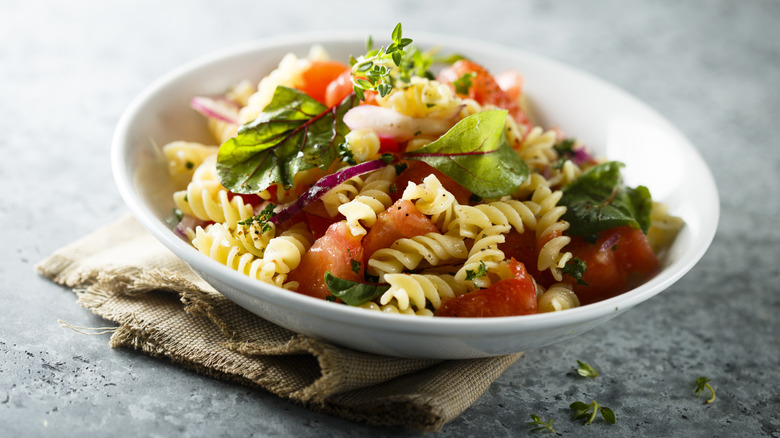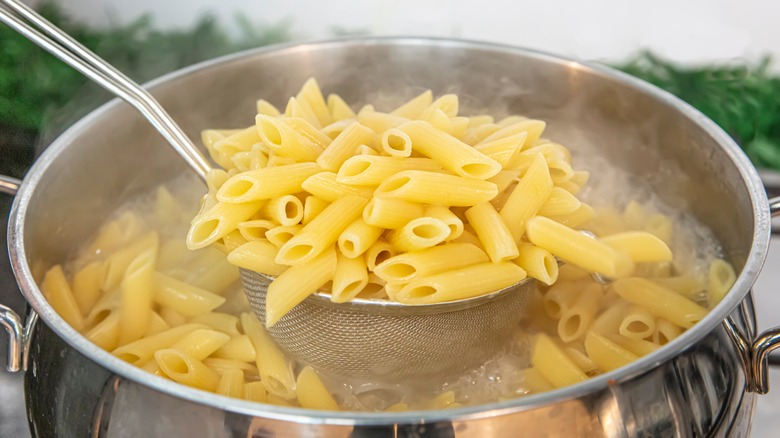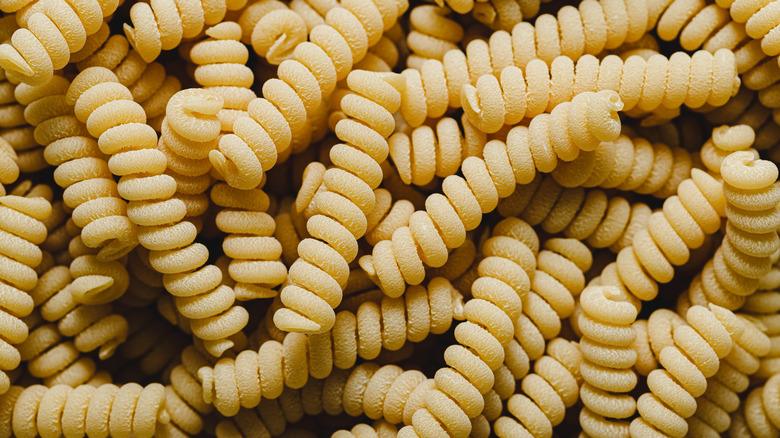The Best Pasta Salad Starts With A Mistake
When making a warm pasta dish, the last thing you want to do is overcook your noodles. In addition to generously salting your water, draining it at the al dente stage is the key to winning the approval of a discerning Italian nonna. Thankfully, pasta salad is a little more forgiving and is even better with overcooked noodles.
While al dente noodles are perfectly toothsome when warm, they don't take kindly to being refrigerated. If you've ever taken a bite of leftover cold spaghetti, you know what we're talking about. This happens because when cooked pasta is refrigerated, its natural starch molecules transform into resistant ones, clinging together in a process called retrogradation. This tightening causes it to become firm, almost rubbery.
However, overcooking your noodles until they're limp makes retrogradation work in your favor, yielding the perfect texture for your pasta salad. This coupled with the fact that it can be made ahead of time, makes this the ultimate low-maintenance side dish.
Why you should rinse your noodles for pasta salad
If you're cringing at the thought of taking your noodles past the al dente stage, hold onto your toques, because we have another piece of sacrilegious advice for making the best pasta salad — rinse your noodles after draining them. While you should avoid rinsing your cooked pasta for warm dishes, as it strips the noodles of the starch that helps sauces cling to them, pasta salad can benefit from a little less starch to further safeguard against toughness and gumminess. It's one of two exceptions to the no-rinse rule, the second being stir-fried dishes made with Asian-style noodles.
But it's important to keep in mind that instead of rinsing the noodles until they're cold, you'll want to keep it quick. Just like Ina Garten's important tip for perfectly dressing any grain salad, incorporating pasta salad dressing while the pasta is still warm will allow for maximum flavor which will only get more delicious after some time in the fridge. The pasta will drink up a lot of that dressing in the fridge, so don't forget to make a little extra to add before serving.
The type of noodle you use for pasta salad matters
When it comes to pasta salad, some shapes are better than others. Trade spaghetti and other thin, long, smooth-surfaced pasta shapes for smaller, sturdier, more irregularly shaped varieties like penne, farfalle, cavatappi, rotini, or macaroni. The small shapes of these noodles are typically the same size as your other ingredients like sliced olives and pieces of salami, making them blend in seamlessly. This also creates the perfect spoonful with every bite.
When it comes to the pasta, the more ridges and curves the better since the noodle can catch all those delicious ingredients. Likewise, it helps better absorb the liquid that binds it all together, whether you use Italian salad dressing or red wine vinegar. We're also particularly drawn to hollow shapes, which are perfect for catching all the delicious bits of crunchy vegetables and mozzarella or feta cheese.
With these tips in mind, you're now ready to go forth and break all the pasta rules you know in the name of a better pasta salad.


